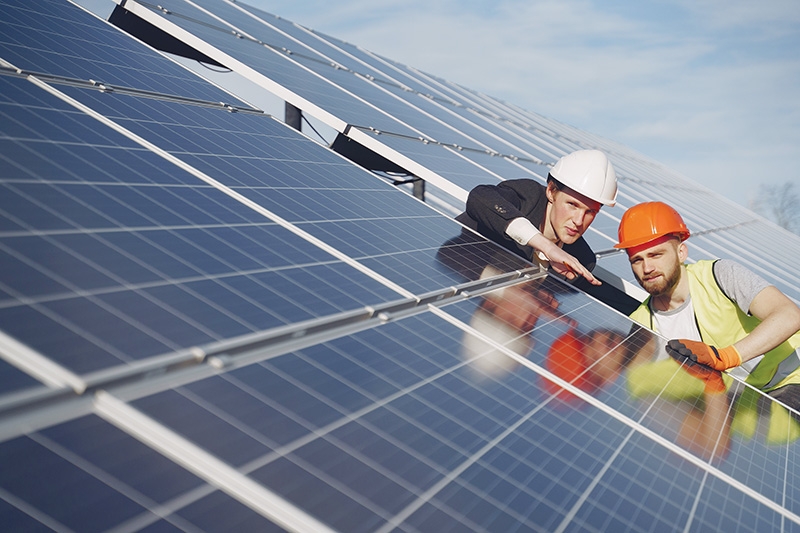Companies continue opting for rooftop solar solutions
 |
| Investment in solar power for high-rise buildings, shopping centres, and more is expected to increase. Photo: Freepik.com |
Nami Solar, a subsidiary of Nami Energy, is expecting to see two rooftop solar power projects commissioned in August after officially launching investment into collaboration with Binh Duong-based Sarah Co., Ltd. and the Mekong Delta province of Long An’s Speed Vina Co., Ltd. in May. Both are South Korean manufacturers and suppliers in the textile and garment industry.
According to Choi Heung Yeon, former standing vice chairman of the Korean Chamber of Commerce and Industry, South Korean investors remain interested in applying clean energy in their operations in Vietnam in order to help reduce their carbon footprints and achieve emission reduction certificates.
Yeon said, “The South Korean government has taken various measures to expand the deployment of renewable energy. As a result, there are strong recommendations from parent companies to their subsidiaries in Vietnam to utilise renewable energy sources including rooftop solar power to drive supply chain innovation.”
Luu Hoang Ha, chairman of Nami Energy, said that 90 per cent of the total electricity from the two solar systems will be used onsite by the two enterprises.
“We will not only support these manufacturers and exporters in adopting clean energy but also assist them in promoting their green image to their target stakeholders in the supply chain,” Ha said.
Firms from various nations remain interested in Vietnam’s solar prospects. The attraction of the solar rooftop market in particular is a focus at a time when the country is facing electricity shortages from next year and likely for several years following.
A total of 9.3 gigawatt-peak of rooftop solar capacity was connected to the national power system by the end of last year, according to state-run Electricity of Vietnam (EVN).
Under the previous feed-in tariff (FiT) 2 of 8.38 US cents for rooftop solar, which closed its application period on December 31, Vietnam’s rooftop solar installations skyrocketed dramatically. However, there is no official release date for FiT3 although its draft set down a rate of 5.3-5.8 US cents per kWh, 30 per cent less than the previous iteration.
Nguyen Ngan, a branding director of locally-invested rooftop developer SolarBK, told VIR, “There is no FiT price for the next phase and the Power Development Plan for 2021-2030 with vision to 2045 has not been officially approved yet. However, I think the demand for rooftop solar power will remain strong as the technology is more advanced, the installation costs are reasonable, and the lifespan of the panels is also getting longer and longer.”
Previously, TrinaSolar explained in local media that for companies using electricity generated from rooftop solar panels, the FiT is not so important, as their focus is not on connecting to the grid and selling electricity to EVN. Using the electricity generated from the rooftop system will reduce the cost of electricity for their day-to-day operations.
In the first months of 2021, a series of large industrial zone (IZ) projects have been approved for investment, also posing as an opportunity for Vietnam to soon apply clean energy to more IZs.
At the same time, investment in solar power for high-rise buildings, shopping centres, and more is expected to become more commonplace as greater focus is laid on saving on electricity costs and protecting the environment.
World Bank research indicates that the technical potentials of 6,000 megawatt-peak and 1,000MWp of rooftop solar systems in Ho Chi Minh City and the central city of Danang will be realised no later than 2025.
“The technical specifications and regulations will be available sooner or later but the capacity installation limit of one megawatt for each rooftop solar system is still a hot topic to discuss among the investment community,” said Mai Van Trung, vice president of Project Development from Nami Energy.
What the stars mean:
★ Poor ★ ★ Promising ★★★ Good ★★★★ Very good ★★★★★ Exceptional
Themes: Sustainable Energy
- 16th national conference on nuclear science and technology opens in Danang
- Technology and Energy Forum 2023 to open in Quang Ninh
- Asia Clean Capital Vietnam receives backing from Swiss Investment Manager
- Amazon scales renewable energy to fight climate change
- Universal Alloy Corporation Vietnam partners with Asia Clean Capital Vietnam
Related Contents
Latest News
More News
- PM orders investment model for North–South high-speed rail (December 22, 2025 | 17:43)
- First members of Danang International Finance Centre revealed (December 22, 2025 | 17:39)
- Securing capital and efficiency for Vietnam’s 2026-2030 growth ambitions (December 17, 2025 | 10:00)
- Driving double-digit growth through green and circular transformation in Vietnam (December 17, 2025 | 09:00)
- Vietnam bucking trend in the global M&A landscape (December 16, 2025 | 14:20)
- Vietnam’s green transition demands collective financial action (December 15, 2025 | 12:00)
- VIR workshop highlights capital and policy for sustainable development (December 15, 2025 | 11:00)
- National Assembly approves pilot mechanisms to accelerate major projects in Hanoi (December 12, 2025 | 11:29)
- Vietnam eases policy approval requirements, simplifies foreign and outbound investments (December 11, 2025 | 17:53)
- Unpacking new momentum in Vietnam’s M&A market (December 10, 2025 | 09:59)

 Tag:
Tag:





















 Mobile Version
Mobile Version